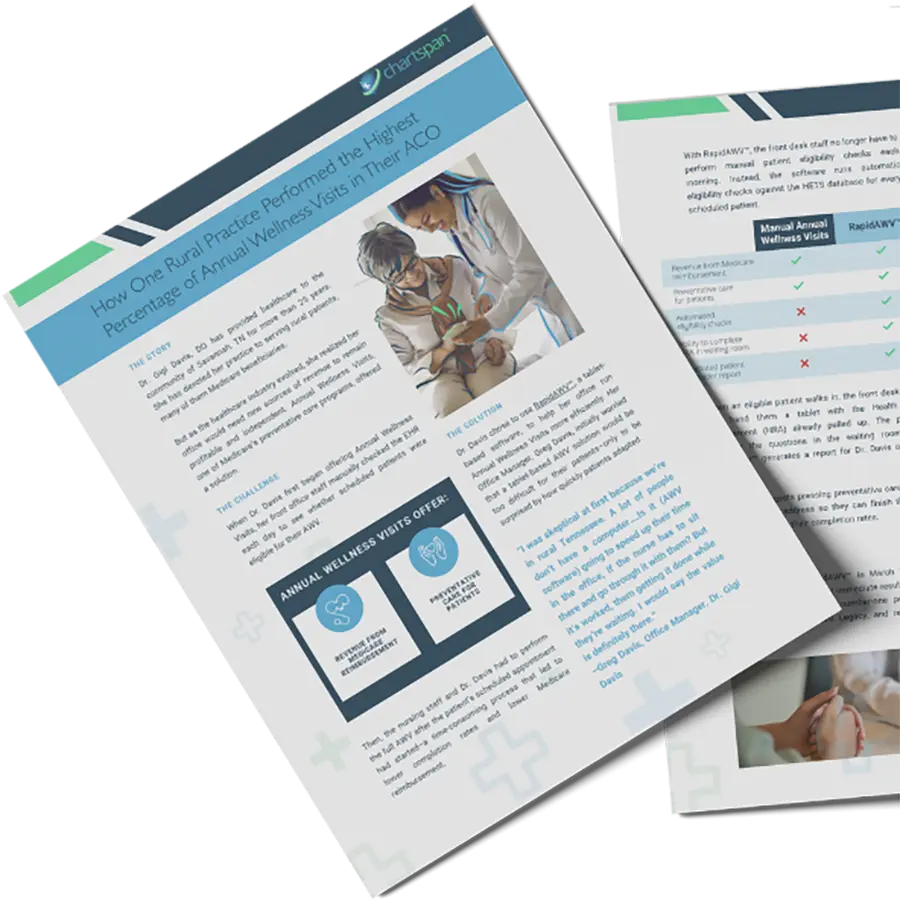
Talk with a ChartSpan Representative Today!
Our team is ready to help you improve patient care and outcomes.
Blog
The Top Three Components Your Medicare AWV Program Needs
Preventive care programs are difficult to administer. Succeeding in those programs with minimal help is a lofty goal that most are unable to attain. Even with Medicare guidelines and requirements to help providers stay on track, preventative programs rarely reach their potential without outside help. Why is this the case? It’s because practices don’t have the time or resources to devote to preventive programs like Annual Wellness Visits and Chronic Care Management. In order to maximize these programs, there are tools and processes that are necessary that most practices don’t have in place. Without these pieces to the puzzle, programs are likely to struggle and often fail altogether. Let’s explore the top components necessary to succeed with Annual Wellness Visit programs, one of CMS’ largest preventive care initiatives.
Annual Wellness Visits (AWV) were designed by the Centers for Medicare and Medicaid Services to focus on identifying risk factors in Medicare patients. By identifying risk factors with an AWV, providers are able to address those risk factors which leads to improved patient outcomes and reduced healthcare spending. CMS offers general guidelines for Annual Wellness Visits, but barely scratches the surface on how to actually run a program. They primarily only provide a few general rules:
- AWVs can only be performed for eligible Medicare beneficiaries by one provider, one time per year.
- AWVs must include documentation of routine measurements, such as blood pressure and body mass index.
- AWVs cannot collect any coinsurance from the patient.
- Eligible Medicare patients cannot have had an AWV within the past year.
Although these guidelines give providers a general framework for the program, they don’t help practice administrators or providers solve the complexities of integrating AWVs into their practice’s daily workflow.
1. Eligibility Verification
In order to get an AWV program started, providers need to be able to establish who is eligible and who is not. One of the most important tools needed to run a successful AWV program is a way to efficiently and accurately identify eligible patients. Although CMS gives guidance on who is eligible for the initial AWV (also referred to as the “Welcome to Medicare”, the initial preventive physical examination, or IPPE) and subsequent AWV, they do not offer a best practice on how to check for eligibility. The most successful way to check for eligibility is to use a third-party software tool that checks against the HETS Medicare eligibility database, instantaneously. Without this kind of functionality, healthcare providers are likely to mistakenly perform Annual Wellness Visits on ineligible patients, or completely miss the opportunity to capture an AWV for an eligible patient whose information is not up-to-date in the EHR.
2. Health Risk Assessment
The AWV is very different from an Annual Physical. While the Annual Physical requires a physical exam during the visit, the AWV is more focused on the responses to a patient Health Risk Assessment (HRA). The HRA is arguably the most important part of the Annual Wellness Visit. It consists of a questionnaire that proposes a series of questions to the patient about their current health and medical history. These questions are able to capture important data about family history, activities of daily living, behavioral risks, functional ability, cognitive impairment, and more. From the HRA responses, a personalized prevention plan is formed and providers are able to assess risk factors, such as fall risk, and suggest appropriate, additional services for the patient, like fall prevention recommendation. There are several tertiary services that can be billed as a result of the AWV completion, including the most commonly added service, Advance Care Planning.
So what is the best format for the HRA to be successful as possible? A pencil and paper questionnaire is not only time-consuming to review the responses but also takes additional time to identify the relevant risk factors and compile them in a separate document. A better solution is to use a software-based HRA that automatically records the responses and uses programmed logic to administer appropriate follow-up questions. The software should then compile the HRA responses and generate an easily digestible risk factor report. Without this, your program is likely to be too time-consuming.
3. Reporting
The responses from the HRA are extremely important and useful to the current provider but can be a lot of information. That’s why it’s crucial for your AWV program to have the ability to take all the collected HRA data and organize it into easily digestible information for providers. The healthcare professional administering the AWV should not have to comb through pages of documents looking for care gaps that need to be addressed. AWV software that uses logic-based formulas that identify and prioritize care gap alerts for providers based on patient responses to HRA questions is a critical feature to any successful AWV program.
Without these top three crucial components of an AWV program, your program is likely to struggle, resulting in worsened patient outcomes, less collected health information, and lower reimbursements that could benefit your practice. These three components combined are guaranteed to complement your practice workflow, no matter if you are a primary care provider, specialty, or even an urgent care clinic. If you are looking for an all-in-one solution that includes these components, look no further than ChartSpan’s AWV software solution, RapidAWV™.
Subscribe for More Insights
Get valuable resources delivered straight to your inbox.
"*" indicates required fields





